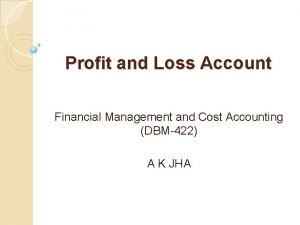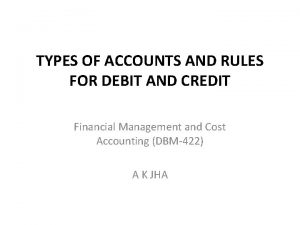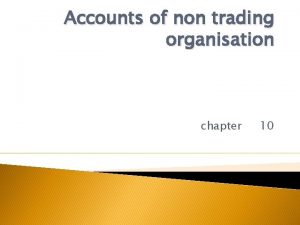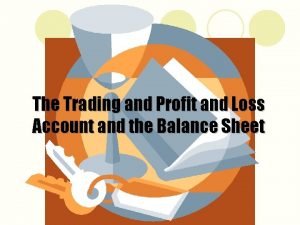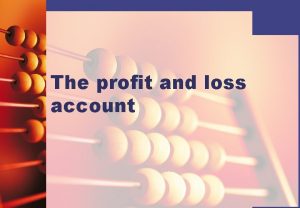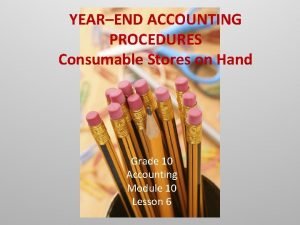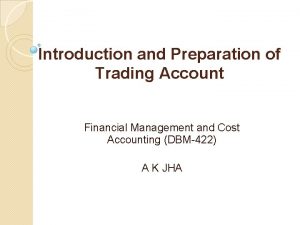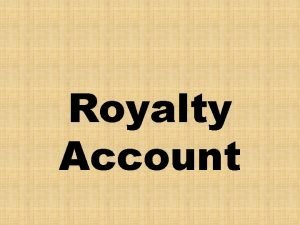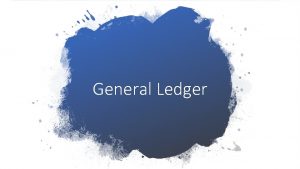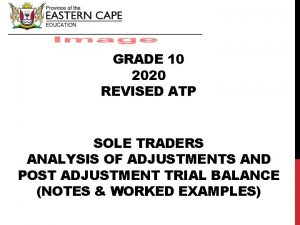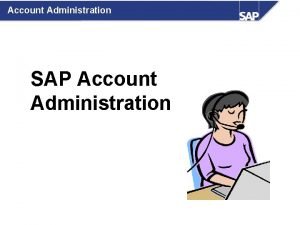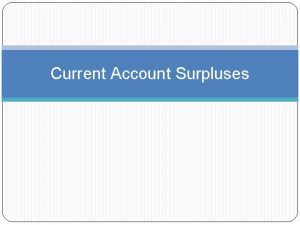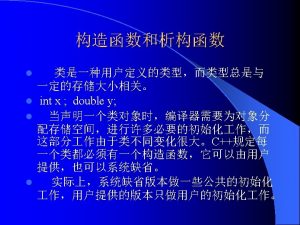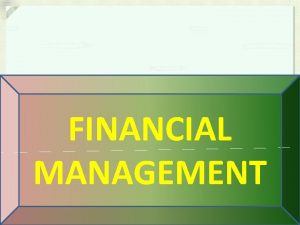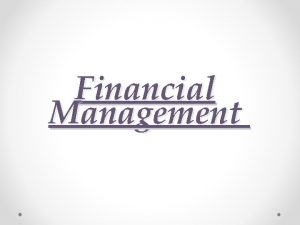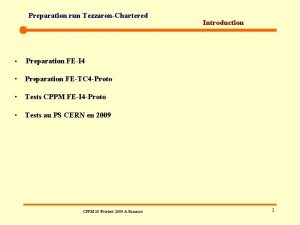Introduction and Preparation of Trading Account Financial Management













- Slides: 13

Introduction and Preparation of Trading Account Financial Management and Cost Accounting (DBM-422) A K JHA

Financial Statement �Financial Statements are prepared to get an idea of profit or loss as well as the financial position of the firm or business. �It is prepared at the end of the financial year. �The financial statements are useful for the users in understanding the position and status of business and making decisions accordingly. �A set of financial statements includes ◦ a Balance Sheet ◦ a Profit and Loss Account ◦ Schedules and notes forming part of balance sheet, and Profit and Loss Account.

Financial Statement � Financial Statements are prepared from the Trial Balance to get an idea of: ◦ How much profit was earned in a particular period? Profit and Loss Account shows the profit earned during the year. ◦ What is financial position of the business at the end of a particular period? Balance Sheet is a position statement that shows the financial position on a particular date. � Balance sheet and Profit and Loss Accounts are the ‘Final Statements or Accounts’. They are the end product of Financial Accounting. � Income statement is the summary of accounts that affects the profit or loss of an enterprise. � An Income Statement has two parts: 1. Trading Account: It reveals gross profit or gross loss 2. Profit and Loss Account: It reveals net profit and net

Trading Account Meaning: Trading Account is prepared to know profitability of business due to buying and selling or manufacturing and selling. It shows the profit from the main business; buying and selling other than the business isn’t included in Trading Account. � Trading Account is the first stage in preparing a final account. It shows the gross profit or gross loss during an accounting year. � Its includes sales, services rendered in the credit side and cost of such sales and services rendered in the debit side. Features of Trading Account 1. It is the first stage in preparation of final accounts. 2. It records only net sales and direct cost of goods sold. 3. The balance of this account discloses the gross profit or gross loss. 4. The balance of this account is transferred to the Profit and Loss Account.

Purpose of Trading Account �It is prepared to find out the gross profit or gross loss during the accounting year. �It is based on matching the selling price of goods and services with the cost of goods sold and services rendered.

Contents of Trading Account 1. Opening Stock refers to the closing balance of the previous year. ◦ ◦ ◦ 2. ◦ It is generally put as first item on the debit side of the Trading account In case of trader, the opening stock consists of different types of finished goods. For manufacturing, the opening stock consists of raw materials, work in process and finished goods Purchases and Purchase Returns The purchase account shows a debit balance, showing the gross amount of purchases made of the materials. � This refers to the goods purchased, both cash and credit purchases for resale. � The purchase of assets meant for permanent use in business such as furniture, machinery are not included

§ § The Purchase Returns Account shows a credit balance showing the returns of materials to the suppliers. On the debit side of the trading account, the net amount is shown as: Rs To Purchase 3, 00 Less: Purchases Returns 0 10, 000 2, 90, 00 entries § Apart from the purchases returns, following 0 should also be deducted § Goods taken by the proprietor for his personal use. § Goods given as charity. § Goods given as samples. Items shown on the Credit Side of the Trading Account 1. Sales and Sales Returns 2. Closing Stock

Direct Expenses 3. ◦ ◦ those expenses which are incurred on the goods purchased till they are brought to the place of business for sale e. g. Freight inward, insurance, import duty, etc. In manufacturing business wages, power and fuel, factory rent, etc. are also direct expenses. Stores consumed during the last year = Opening Balance in Stores + Purchase of Sores during the year – Closing Balance of Stores

Balancing of Trading Account Gross Profit or Gross Loss �After recording the above items in the respective sides of the Trading Account, the balance is calculated to ascertain Gross Profit and Gross Loss. �If the total of the credit side is more than that of debit side, the excess is Gross Profit. �If the total of the debit side is more than that of credit side, the excess is Gross Loss.

Advantage of Trading Account 1. The various items of trading can be known separately. 2. Over stocking or under stocking can be known 3. The result of trading can be known separately. 4. The progress can be studied on the basis of gross profit ratio, year by year

Dr. Name of the Firm Trading Account For the year ended on 31 st March Cr. Particulars Amount To Opening stock By Sales less Returns To Purchase less return By Closing To Wages Stock To Carriage Balancing To Freight figure To Fuel Gross loss To Stores consumed (transferred to To Royalty P and L A/c) To Manufacturing Expenses To Profit and Loss A/c Balancing figure Gross Profit (transferred to P and L A/c)

Example 1. Prepare a Trading Account for the year ending March 31, 2019 from the following balances as at March 31, 2019 Particulars Amount (Rs) Opening stock : Raw material 20000 Finished Goods 35000 Purchase 90000 Sales 175000 Returns: Purchase 2500 Sales 1500 Wages 32500 Factory Expenses 22500 Freight : In wards 5000 Out wards 7500 At the period of the concerned period the stock on hand 17500 were: 5000 Raw Material 27500 Work in progress Finished Goods

Name of the Firm Trading Account For the year ending March 31, 2019 Dr. Particulars To Opening Stock: Raw Material Finished goods To Purchases 90000 Less Return 2500 To Wages To Factor Expenses To Freight Inwards To Gross Profit Total Cr. Amount (Rs) 20000 35000 87500 32500 22500 5000 21000 223500 Particular Amount (Rs) By Sales: 173500 17500 Less : Return 5000 1500 27500 By Closing Stock: Raw Materials Work in process Finished goods 223500
 Errors revealed by trial balance with examples
Errors revealed by trial balance with examples Particulars
Particulars 3 types of accounts
3 types of accounts Meaning of non trading organisation
Meaning of non trading organisation P&l format
P&l format How to calculate sales ratio in departmental accounts
How to calculate sales ratio in departmental accounts Profit and loss
Profit and loss Trading profit and loss account layout
Trading profit and loss account layout What type of account is consumable stores
What type of account is consumable stores Trading account is prepared to find out? *
Trading account is prepared to find out? * Royalty accounts journal entries
Royalty accounts journal entries Trading account general ledger
Trading account general ledger Refreshments trading account
Refreshments trading account General ledger grade 10
General ledger grade 10

